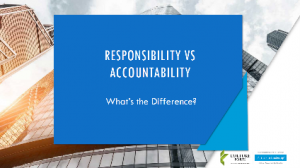
NEWS
News
4-Feb-2023
Responsibility vs. Accountability
Source Article | Accountability Insights from Partners in Leadership | Adapted
 Who is Accountable[/caption]
While the words responsibility and accountability are often used interchangeably, we believe there is an important and fundamental difference between the two—a night and day difference—and that currently adopted definitions for accountability are wrong. We appreciate the definitions and respect the notion of being responsible and the need for it, but we know from decades of experience that accountability is something truly empowering, not something consequential (“subject to; answerable”). When people use these two words synonymously, this misapplication can unintentionally create tendencies to blame, add unnecessary confusion, cause disengagement, and lead to poor performance.
Who is Accountable[/caption]
While the words responsibility and accountability are often used interchangeably, we believe there is an important and fundamental difference between the two—a night and day difference—and that currently adopted definitions for accountability are wrong. We appreciate the definitions and respect the notion of being responsible and the need for it, but we know from decades of experience that accountability is something truly empowering, not something consequential (“subject to; answerable”). When people use these two words synonymously, this misapplication can unintentionally create tendencies to blame, add unnecessary confusion, cause disengagement, and lead to poor performance.
 RESPONSIBILITY VS. ACCOUNTABILITY EBOOK
Read our eBook, Responsibility vs. Accountability, to learn more about the subtle, but crucial, differences between responsibility and accountability.
> Download now
Organizations often try to solve these problems by redefining responsibilities—reorganizing what people do and restructuring the way work is done—only to find that changing where people sit in the organization won’t necessarily change how they think and perform. What they are lacking is personal accountability—involving a choice to move closer to the success that you or your organization wants. When you step up to greater personal accountability, employees stop blaming each other, salespeople stop blaming the marketplace, companies stop blaming their competitors, and we all stop blaming the economy—you get the picture. Finding convenient reasons to shift responsibility or blame is never effective and never brings better results.
RESPONSIBILITY VS. ACCOUNTABILITY EBOOK
Read our eBook, Responsibility vs. Accountability, to learn more about the subtle, but crucial, differences between responsibility and accountability.
> Download now
Organizations often try to solve these problems by redefining responsibilities—reorganizing what people do and restructuring the way work is done—only to find that changing where people sit in the organization won’t necessarily change how they think and perform. What they are lacking is personal accountability—involving a choice to move closer to the success that you or your organization wants. When you step up to greater personal accountability, employees stop blaming each other, salespeople stop blaming the marketplace, companies stop blaming their competitors, and we all stop blaming the economy—you get the picture. Finding convenient reasons to shift responsibility or blame is never effective and never brings better results.
Choose Accountability
When a result isn’t achieved, that’s when most of us start hearing words like “responsibility” and “accountability.” While responsibility is appreciated and often used correctly, accountability continues to be misperceived and gets a bad rap—we’re here to tell you why it shouldn’t.Two Words, Two Meanings
The words responsibility and accountability rear their heads when people start talking about results—especially when the desired results are not achieved. That’s when remarks and phrases like, “Who’s responsible for missing the deadline?!” and “Which department is accountable for not delivering our goals?” begin to get thrown around. Are these words being used correctly? As the pioneers of Accountability Training®, we often get questions around the differences between these two words and how they tie to the achievement of results. In fact, many professionals we work with initially don’t think they have accountability issues but, rather, believe that they have responsibility issues instead. It’s not until we demonstrate the way we address accountability that they begin to see that accountability, not responsibility, plays a major role in overcoming almost every challenge they face. To do this, we first help them understand that the definition of accountability is broken and must be fixed to be truly grasped. Dictionary.com defines each as: Accountable: “subject to the obligation to report, explain, or justify something; responsible; answerable.” Responsible: “answerable or accountable, as for something within one’s power, control, or management.” [caption id="attachment_74661" align="alignleft" width="185"] Who is Accountable[/caption]
While the words responsibility and accountability are often used interchangeably, we believe there is an important and fundamental difference between the two—a night and day difference—and that currently adopted definitions for accountability are wrong. We appreciate the definitions and respect the notion of being responsible and the need for it, but we know from decades of experience that accountability is something truly empowering, not something consequential (“subject to; answerable”). When people use these two words synonymously, this misapplication can unintentionally create tendencies to blame, add unnecessary confusion, cause disengagement, and lead to poor performance.
Who is Accountable[/caption]
While the words responsibility and accountability are often used interchangeably, we believe there is an important and fundamental difference between the two—a night and day difference—and that currently adopted definitions for accountability are wrong. We appreciate the definitions and respect the notion of being responsible and the need for it, but we know from decades of experience that accountability is something truly empowering, not something consequential (“subject to; answerable”). When people use these two words synonymously, this misapplication can unintentionally create tendencies to blame, add unnecessary confusion, cause disengagement, and lead to poor performance.
Is More “Responsibility” Going to Lead to Success?
For instance, a responsible team or organization can be successful in many ways:- Define roles and job descriptions with focus.
- Establish clear organizational hierarchies.
- Have processes and systems in place.
- Have feedback sessions in the form of reviews.
- Even consistently hit their numbers.
- Siloed thinking and acting with reluctant behaviors around getting involved in things outside their control.
- “I thought you had it” mentalities where people ignore and deny one another’s ability to positively contribute.
- Attitudes where people justify the ways they think and act to cover their tails.
- Poor performance and development due to infrequent feedback exchanges.
80%
80% of those surveyed say feedback is something that happens to them only when things go wrong or not at all. RESPONSIBILITY VS. ACCOUNTABILITY EBOOK
Read our eBook, Responsibility vs. Accountability, to learn more about the subtle, but crucial, differences between responsibility and accountability.
> Download now
Organizations often try to solve these problems by redefining responsibilities—reorganizing what people do and restructuring the way work is done—only to find that changing where people sit in the organization won’t necessarily change how they think and perform. What they are lacking is personal accountability—involving a choice to move closer to the success that you or your organization wants. When you step up to greater personal accountability, employees stop blaming each other, salespeople stop blaming the marketplace, companies stop blaming their competitors, and we all stop blaming the economy—you get the picture. Finding convenient reasons to shift responsibility or blame is never effective and never brings better results.
RESPONSIBILITY VS. ACCOUNTABILITY EBOOK
Read our eBook, Responsibility vs. Accountability, to learn more about the subtle, but crucial, differences between responsibility and accountability.
> Download now
Organizations often try to solve these problems by redefining responsibilities—reorganizing what people do and restructuring the way work is done—only to find that changing where people sit in the organization won’t necessarily change how they think and perform. What they are lacking is personal accountability—involving a choice to move closer to the success that you or your organization wants. When you step up to greater personal accountability, employees stop blaming each other, salespeople stop blaming the marketplace, companies stop blaming their competitors, and we all stop blaming the economy—you get the picture. Finding convenient reasons to shift responsibility or blame is never effective and never brings better results.
Accountability: The Secret Sauce of Responsibility
Clearly defining responsibility is certainly essential, but encouraging people to go a step further to get personally involved will secure better results every time. That’s where taking accountability comes into play. The notion of “taking accountability” naturally sounds more significant than “having responsibility”—you’re making the choice to go beyond what you’re responsible for, carrying with it an idea of ownership, involvement, and engagement. Earlier we looked at how a responsible team or organization might function. Now, let’s look at an accountable team or organization. In a workplace culture where this positive and empowering version of accountability is embraced, you’ll find that:- People at all levels take ownership for the strategic results of the organization.
- Balls do not get dropped and projects do not slip through the cracks.
- People think differently about the job that needs to get done.
- People break-down barriers and collaborate to achieve the right results.
Getting Positive Accountability
It’s not hard to see that the prevailing notions of accountability need to be fixed—we need something more positively defined as “a personal choice to rise above one’s circumstances and demonstrate the ownership necessary for achieving desired results.” When you shift mindsets and thought processes this way, you’ll begin to see and feel traction in yourself and in others. Over nearly three decades of working with some of the world’s top organizations and leaders, we’ve observed 16 Accountability Traits that are the essence of “taking accountability” which includes being good at hearing and saying the hard things to see reality, ensuring one’s work is aligned with the key results, collaborating across functional boundaries and building an environment of trust. These 16 traits have proven, over time, as being the mandatory actions that create the process of taking positive accountability. Adopt the right mindset and step up to these traits and you’ll quickly realize that accountability is not assigned, not put upon, not, at times, so exactly defined that it creates silos, finger pointing, and the blame game. It is chosen.Making the Choice
Working on getting good at the 16 Accountability Traits is just that—work. Where do you begin?- Look them over and be honest with yourself on the ones you need to improve.
- Think about what you can do better and where you can help others.
- Then, do them!
News
25-Mar-2019
The 5 Cs: 5 Essential Qualities That Define Great Leadership
Want to be a stronger leader? Build a stronger team on these five principles.

Article | Accountability Insights by | Feb 7, 2019 | Published with permission from Partners in Leadership
Many leaders focus on upward movement within their organization, deciding ways they can ascend the ranks in their company. However, fighting hard to get to the top doesn’t necessarily make for a strong leader. There’s another approach you can take to improve your leadership skills that is more rewarding and far less lonely: surrounding yourself with great people. But how do you find and cultivate strong workers?
According to the 2018 Gallup Employee Engagement report, only 34 percent of people in the U.S. are engaged in their work. Although this number is quite low, you may be surprised to learn that this is the highest percentage in the history of Gallup’s employee engagement reporting. The number of disengaged workers has reached an all-time low of 13 percent. Despite these record-breaking statistics, U.S. employees’ lack of engagement can have disastrous impacts on the success of their organizations. Perhaps these figures are a direct result of poor leadership.
To inspire engagement and effectiveness in their employees, leaders should look within, asking themselves the following questions:
- How clear and communicative are you as a leader?
- What is your leadership style?
- Do you practice what you preach?
- Do you keep the promises you make?






